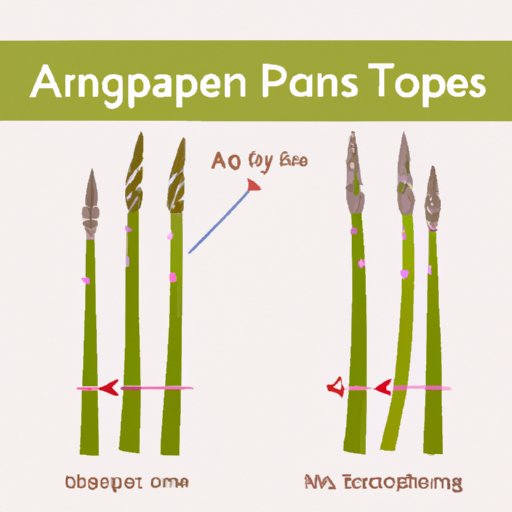
Introduction
Asparagus is a nutritious and delicious vegetable that can easily be grown in your own backyard. Not only will you enjoy the satisfaction of growing your own food, but you will also have access to fresh asparagus whenever you want it. In this article, we will cover step-by-step instructions for planting asparagus, the benefits of growing and eating it, ideal soil and climate requirements, container gardening techniques, planning tips, and companion planting options to make your asparagus thrive.
Step-by-Step Guide to Planting Asparagus
Before planting, it is important to research the soil type, pH level, and fertilizers that are best suited for asparagus. It is also important to space the plants correctly for optimal growth, plant the crowns properly, and regularly mulch and water the plants. Caring for young shoots is also essential to ensure a healthy harvest.
Preparing the Soil
Asparagus prefers well-draining soil with a pH level of 6.0-7.5. It is important to amend the soil by adding compost or well-rotted manure to improve soil texture and drainage. Fertilizers high in nitrogen should be avoided as they can inhibit root growth. Additionally, be sure to weed the planting area before planting to prevent competition for nutrients.
Spacing the Plants
Asparagus should be planted 12-18 inches apart in rows that are at least 3 feet apart. Dig trenches 6-8 inches deep and place the crowns at the bottom of the trench with the top facing up. Cover the crowns with 2-3 inches of soil and water gently. As the plants grow, gradually fill in the trench until it is level with the surrounding soil.
Planting the Crowns
Crowns should be chosen that have healthy, plump roots with a few buds on top. The buds should be buried under 2-3 inches of soil. Be sure to water the crowns well immediately after planting.
Mulching and Watering
Once the plants have emerged, mulch around them with straw, leaves, or other organic material to help retain moisture and prevent weed growth. Keep the soil consistently moist but not waterlogged. It is better to water deeply once a week rather than lightly and frequently.
Caring for Young Shoots
Young asparagus shoots should be pruned to allow the best shoots to grow and the weaker ones to die off. Weeding should be done regularly to prevent competition for nutrients. Additionally, asparagus beetles and fungus can be a problem, so it is important to monitor for signs of these pests and diseases and take action accordingly.
Benefits of Planting and Eating Asparagus
Asparagus is high in vitamin C, fiber, and antioxidants. It can also support healthy digestion, reduce inflammation, and may even help prevent certain types of cancer. Cultivating your own asparagus can be more sustainable and affordable than buying it from the store. There are many ways to incorporate asparagus into your diet, including roasting, grilling, adding it to salads, or making it into soups or stews. It is a versatile vegetable that can be enjoyed in many different ways.
Soil and Climate Requirements for Growing Asparagus
Asparagus thrives in climates with cool winters and moderate to warm summers. It prefers well-draining soil with a pH level of 6.0-7.5. It is important to test your soil prior to planting to ensure the pH is within the proper range. Additionally, asparagus requires consistent soil moisture, so be sure to water regularly and mulch around the plants to help retain moisture. Common pests and diseases that can affect asparagus include asparagus beetles, fungus, and rust. Regular monitoring and taking preventative measures can help prevent these issues.
Container Gardening for Asparagus
Growing asparagus in containers can be a good option for those with limited space or poor soil conditions. However, it is important to choose a container that is large enough, has good drainage, and is deep enough to accommodate the long roots. Plant asparagus crowns in the center of the pot and add well-draining soil mixed with compost. Fertilize the plants regularly and water deeply as they grow.
Planning Techniques for Planting Asparagus
Before planting asparagus, it is important to assess the site for optimal growing conditions. This includes evaluating light exposure, soil quality, drainage, and other key factors. Once a suitable site has been chosen, be sure to properly prepare the soil, add amendments, and space the plants correctly. Caring for young shoots requires regular pruning, weeding, and monitoring for pests and diseases.
Companion Planting with Asparagus
Companion planting can be a great way to improve soil health and control pests and diseases in your garden. Some good companion plants for asparagus include mint, parsley, tomatoes, and marigolds. However, be sure to research companion planting options specific to your area and be mindful of how different plants interact with each other.
Conclusion
Growing and enjoying fresh asparagus is a rewarding experience that can offer many health benefits. Planting asparagus requires proper preparation of the soil, spacing, planting, watering, and care for young shoots. Asparagus can be grown in containers for those with limited space or poor soil conditions. Proper planning and companion planting techniques can also aid in the success of your asparagus plants. Whether enjoyed grilled, roasted, or in a salad, asparagus is a versatile and nutritious vegetable that is worth growing in your own backyard.





